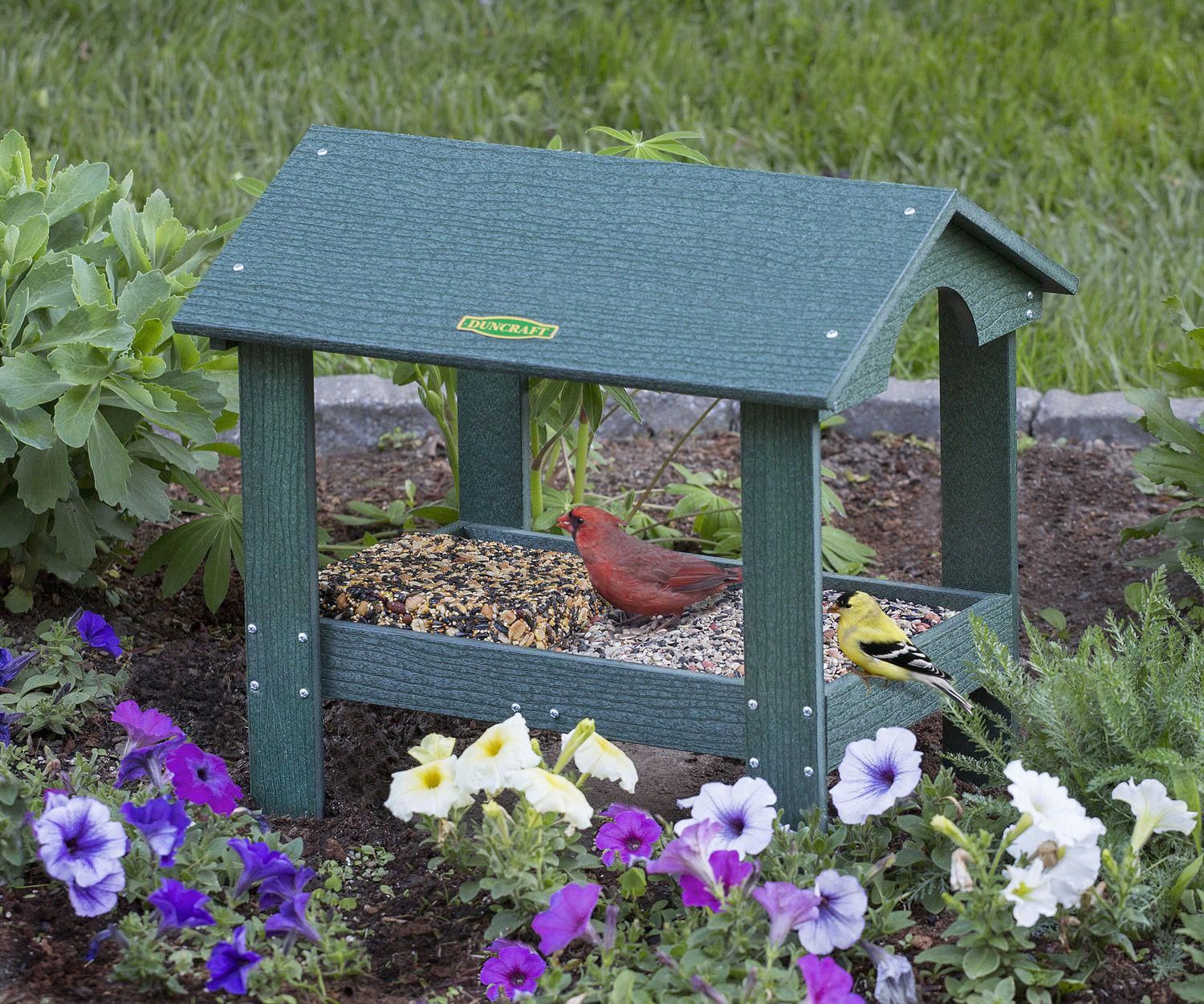Ground feeding birds flock to platform feeders placed right on the ground. Unlike hanging feeders, these ground-level food sources give all birds easy access. And models with roofs offer an extra benefit – protection from the elements for feeding birds.
In this article, we’ll look at why roofed ground feeders are ideal, the different types available, tips for choosing, filling, and maintaining one, and the joy of ground feeding diverse avian species in your yard.
Why Choose a Covered Ground Bird Feeder?
Ground feeders with roofs have some clear advantages over open tray-style platforms
-
Shelter from rain/snow – Roofs prevent the seed from getting soaked during precipitation, which is unhealthy for birds The cover also lets birds stay dry while eating.
-
Shade from sun – A roof provides shade and cooling that open feeders lack. This helps feeders not overheat on hot days.
-
Deters larger pests – Squirrels and some other wildlife have a harder time stealing seed from covered feeders with small bird entryways.
-
Prevents seed waste – Seed stays fresh and dry longer, reducing spoilage and waste. The cover also keeps seed more contained.
-
Feels safer for birds – Shy ground feeders like doves may feel more protected in an enclosed feeder, leading to more activity.
Popular Styles of Covered Ground Platform Feeders
Gazebo/House Feeders
These feeders have an enclosed house or gazebo-like design with small entrances for birds. The cover provides nearly full rain and sun protection. Gazebo feeders deter squirrels and blend into landscapes.
Tray Feeders
Long tray feeders typically have a slanted roof that covers the platform. Birds access the seed through open sides or slots. The simple roof offers partial coverage from the elements.
Hopper Feeders
Ground hoppers have a covered bin that dispenses seed into an open tray below. Their roofs gives overhead shelter. Squirrel-proof hoppers close access when something heavy disturbs them.
Tips for Choosing a Ground Bird Feeder with Roof
When selecting a roofed ground feeder, keep these tips in mind:
-
Choose sturdy metal, wood, or thick plastic models that resist damage from weather and squirrels.
-
For gazebo styles, make sure the bird entry spaces aren’t too big – 1.5 inches wide or less discourages squirrels.
-
Opt for a large 4+ pound capacity to serve more birds and require less refilling.
-
Look for affordable tray feeders if you want good coverage at a lower cost.
-
Seek feeders with drainage holes so rainwater doesn’t accumulate inside.
-
Consider rust-resistant metals like powder coated steel that hold up well outdoors.
-
Seek removable roofs for easy interior access during cleaning and filling. Detachable trays also help.
Where to Place a Covered Ground Bird Feeder
Once you’ve picked the right feeder, proper placement is key:
-
Choose a spot about 10 feet from trees/shrubs where birds can escape but avoid ambush by cats.
-
Place it in a dry area with good drainage – not where water collects.
-
Set it near natural cover like bushes so shy birds feel protected while approaching.
-
Point the feeding entrances towards any nearby vegetation to create a sense of safety.
-
Avoid high traffic spots or paths that people/pets frequently use.
Filling Your Ground Feeder with Yummy Foods
Now for the fun part – filling the feeder! Here are healthy options birds relish:
-
Seed mixes – Look for small seeds like millet, cracked corn, and sunflower chips that suit ground feeders.
-
Peanuts – Whole or chopped peanuts appeal to jays and others. Sparrows love peanut hearts.
-
Fruit – Finely chopped fruits like grapes, berries, and apples attract many species.
-
Mealworms – Live or dried mealworms are protein rich and entice robins, thrushes, and more.
-
Suet – Ground suet feeders or suet crumbles/nuggets are excellent high-energy winter foods.
Don’t overfill. Leave some space in domed feeders so lid closes properly. Check often to refresh and replace soggy seed.
Caring for Your Covered Ground Feeder
With regular care, a covered ground feeder will provide years of service:
-
Check feeders daily and brush off any accumulated dirt, bird droppings, or mold.
-
Take feeders apart weekly for deeper cleaning with a mild soap and water solution if needed.
-
Rake or sweep up fallen seed hulls and husks around the feeder regularly to keep the area clean.
-
Wipe down any metal components that get wet to prevent rusting.
-
Disinfect plastic/metal feeders 2-3 times per year with a 10% bleach solution.
-
Repair any damage right away – cracked plastic, holes in metal, etc. A feeder in disrepair can harm birds.
Enjoy the Bird Traffic at Your Ground Feeder!
Well-stocked covered ground feeders attract an array of beautiful feathered friends. You’re likely to see:
-
Mourning doves – These graceful ground foragers gather under platform feeders, often in groups.
-
Juncos – Look for these “snowbirds” hopping about ground feeders in flocks during winter.
-
Sparrows – Several kinds of sparrows scour the ground beneath platform feeders.
-
Finches – House and purple finches scratch below covered feeders picking fallen seeds.
-
Towhees – These striking birds consume lots of seed from ground feeders. Listen for their “drink-your-tea” calls.
-
Quail – From California to Bobwhite, quail visit covered ground feeders but only briefly.
Ground feeding birds will thank you for setting up a sturdy, sheltered feeder. Try one this season to enjoy eye-level looks at colorful ground foragers in your yard.
Ground Bird Feeders | The RSPB
FAQ
Is it OK to sprinkle bird seed on the ground?
Do birds like ground feeders?
What do you put under a bird feeder ground?
How high off the ground should a bird feeder be?

